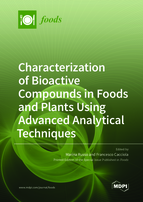Characterization of Bioactive Compounds in Foods and Plants Using Advanced Analytical Techniques
A special issue of Foods (ISSN 2304-8158). This special issue belongs to the section "Food Engineering and Technology".
Deadline for manuscript submissions: closed (10 June 2021) | Viewed by 40934
Special Issue Editors
Interests: food chemistry; bioactive molecules; liquid chromatography; mass spectrometry; extraction
Special Issues, Collections and Topics in MDPI journals
Interests: food chemistry; natural products; plant extracts; antioxidants; polyphenols; carotenoids; liquid chromatography; comprehensive two-dimensional liquid chromatography; mass spectrometry
Special Issues, Collections and Topics in MDPI journals
Special Issue Information
Dear Colleagues,
Since the 1990s, food chemistry has opened a new chapter in foods and plants investigation. Increasing attention to secondary metabolites and micro-constituents of nutraceutical interest present in foods has been noticed, supporting previous studies on macronutrient composition. Thanks to positive scientific opinions on the presence of bioactive molecules in plants and foods, the previous vision of foods exclusively from a “caloric” point of view has been changed looking at foodstuffs as having positive effects on human health.
This Special Issue focuses on the optimization and validation of advanced analytical methodologies dedicated to the characterization and valorisation of foods and plants containing bioactive molecules. Quali-quantitative characterization, food security, traceability, innovation in the field of nutraceutical and functional nutrition will be of particular interest in order to stimulate a dialogue on correct nutrition concept in a cultural, technological and climate context in constant change.
It is my great pleasure and honor to invite you to contribute to this Special Issue.
Prof. Marina Russo
Prof. Francesco Cacciola
Guest Editors
Manuscript Submission Information
Manuscripts should be submitted online at www.mdpi.com by registering and logging in to this website. Once you are registered, click here to go to the submission form. Manuscripts can be submitted until the deadline. All submissions that pass pre-check are peer-reviewed. Accepted papers will be published continuously in the journal (as soon as accepted) and will be listed together on the special issue website. Research articles, review articles as well as short communications are invited. For planned papers, a title and short abstract (about 100 words) can be sent to the Editorial Office for announcement on this website.
Submitted manuscripts should not have been published previously, nor be under consideration for publication elsewhere (except conference proceedings papers). All manuscripts are thoroughly refereed through a single-blind peer-review process. A guide for authors and other relevant information for submission of manuscripts is available on the Instructions for Authors page. Foods is an international peer-reviewed open access semimonthly journal published by MDPI.
Please visit the Instructions for Authors page before submitting a manuscript. The Article Processing Charge (APC) for publication in this open access journal is 2900 CHF (Swiss Francs). Submitted papers should be well formatted and use good English. Authors may use MDPI's English editing service prior to publication or during author revisions.
Keywords
- Bioactive molecules
- Nutraceutical
- Superfoods
- Functional nutrition
- HPLC
- GC
- Food security








